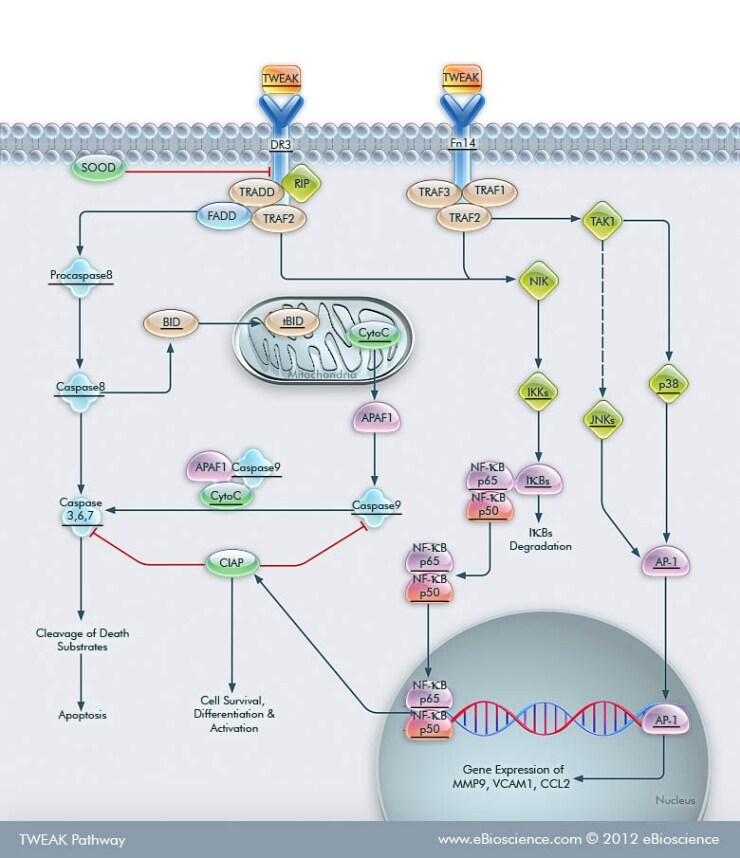Search
TWEAK Pathway
TWEAK is a cell surface-associated type II transmembrane protein (249-amino acid) belonging to the TNF (Tumor Necrosis Factor) superfamily. The protein was named TWEAK for its relatedness to TNF and its weak apoptotic ability. The predicted cytoplasmic, transmembrane and extracellular domains of TWEAK consist of amino acids 1-18, 19-42, and 43-249, respectively. TWEAK has multiple biological activities, including stimulation of cell growth and angiogenesis, induction of inflammatory cytokines, and, under some experimental conditions, stimulation of apoptosis. TWEAK functions as a novel pathogenic mediator by amplifying inflammation, promoting tissue damage, and potentially impeding endogenous repair mechanisms. It is produced by IFN-gamma-stimulated monocytes and induces multiple pathways of cell death, including Caspase-dependent apoptosis, Cathepsin-B-dependent necrosis, and endogenous TNF-Alpha-mediated cell death, in a cell type-specific manner. However, the TWEAK receptor(s) that mediates these multiple death pathways remains to be identified. It was first described as inducing apoptosis by interacting with DR3 (Death Receptor-3) [1,2].
DR3 is a Type-I membrane protein belonging to the TNFR (Tumor Necrosis Factor Receptor) family, and it contains the DD homologous to TNFR1, Fas, TRAILR1, and TRAILR2. The TWEAK receptor DR3 (also known as Apo3, LARD, WSL1 or TRAMP) is expressed predominantly in tissues with high lymphocyte content. DR3 contains a set of cysteine-rich domains in the extracellular region and a death domain in its cytoplasmic segment. DR3 transduce death signals by interaction of their DD with FADD (Fas Associated Death Domain), a DD-containing cytoplasmic protein. FADD then recruits other cytoplasmic effectors such as Caspase8, TRADD (TNFR-Associated Death Domain protein) and RIP (Receptor-Interacting Protein) that activate the apoptotic machinery. DR3 also recruits TRAF2 (TNF Receptor-Associated Factor-2) via TRADD and thus activates the transcription factor, NF-KappaB that induces the transcription of a number survival genes including IAP (Inhibitor of Apoptosis). In this respect, DR3 (like TNFR1) is capable of inducing both apoptosis and expression of survival/activation genes and is likely to have multiple functions depending on the context of its expression. The recently identified SODD (Silencer of Death Domains) that can interact with the DDs of DR3 is thought to be a first member of a class of proteins that inhibits the spontaneous self-aggregation of receptor DDs. Cross-linking of the receptor results in the release of SODD and the recruitment of intracellular adapter molecules like TRADD and FADD. Identification of DR3 as the major receptor for TWEAK is controversial. This has been challenged by reports, which showed that TWEAK could induce cell death in cells lacking DR3 [3].
TWEAK binds a small cell surface receptor known as Fn14(fibroblast growth factor-inducible 14) [4].Interaction between TWEAK and Fn14 plays a role in cell death, regulation of the permeability of the neurovascular unit. This two proteins are expressed in the CNS (central nervous system). Under physiological and pathological conditions and in response to a variety of stimuli, including cerebral ischemia, there is an increase in TWEAK and Fn14 expression in perivascular astrocytes, microglia, endothelial cells, and neurons with subsequent increase in the permeability of the blood-brain barrier and cell death. Furthermore, there is a growing body of evidence indicating that TWEAK induces the activation of the NF-kappaB in the CNS with release of proinflammatory cytokines and matrix metalloproteinases. In addition, inhibition of TWEAK activity by either treatment with a Fn14-Fc fusion protein or neutralizing anti-TWEAK antibodies has shown therapeutic efficacy in animal models of ischemic stroke, cerebral edema, and multiple sclerosis. TweakR/Fn14 is the smallest member of the TNFR superfamily described to date, and it appears to signal via recruitment of several different TNFR-associated factors. The cytoplasmic domain of Fn14, like other members of the TNFR superfamily, does not contain consensus amino acid sequences characteristic of domains with enzymatic activity. The TRAF (TNF Receptor-Associated Factor) family proteins were identified as signal transducers that bound to several members of the TNFR superfamily, leading to the activation of NF-KappaB and MAPK (Mitogen-Activated Protein Kinases). TRAF2, TRAF5 and TRAF6 were shown to activate NF-KappaB and to be involved in NF-KappaB activation mediated by these receptors. Previous reports showed that the cytoplasmic domain of Fn14 bound to TRAF1, TRAF2, TRAF3 and TRAF5. TWEAK is a potent inducer of endothelial cell survival and cooperates with basic fibroblast growth factor to induce the proliferation and migration of human endothelial cells and morphogenesis of capillary lumens. In contrast, TWEAK antagonizes the morphogenic response of endothelial cells to VEGF (Vascular Endothelial Growth Factor) without inhibiting VEGF-induced survival or proliferation. Thus, TWEAK may differentially regulate microvascular growth, remodeling and/or maintenance in vivo, depending upon the angiogenic context [4-6].
Pathway

Key

- Burkly LC, Michaelson JS, Hahm K, et al. (2007) TWEAKing tissue remodeling by a multifunctional cytokine: role of TWEAK/Fn14 pathway in health and disease. Cytokine 40(1):1-16. Epub 2007 Nov 5. Review.
- Desplat-Jégo S, Feuillet L, Creidy R, et al. (2008) TWEAK is expressed at the cell surface of monocytes during multiple sclerosis. J Leukoc Biol 85(1):132-5. Epub 2008 Oct 22.
- Kumar M, Makonchuk DY, Li H, Mittal A, Kumar A. (2009) TNF-like weak inducer of apoptosis (TWEAK) activates proinflammatory signaling pathways and gene expression through the activation of TGF-beta-activated kinase 1. J Immunol 182(4):2439-48.
- Yepes M (2007) TWEAK and the central nervous system. Mol Neurobiol 35(3):255-65. Review.
- Perper SJ, Browning B, Burkly LC, et al. (2006) TWEAK is a novel arthritogenic mediator. J Immunol 177(4):2610-20.
- Blanco-Colio LM, Martín-Ventura JL, Munoz-Garcia B, et al. (2007) TWEAK and Fn14. New players in the pathogenesis of atherosclerosis. Front Biosci 12:3648-55. Review.
